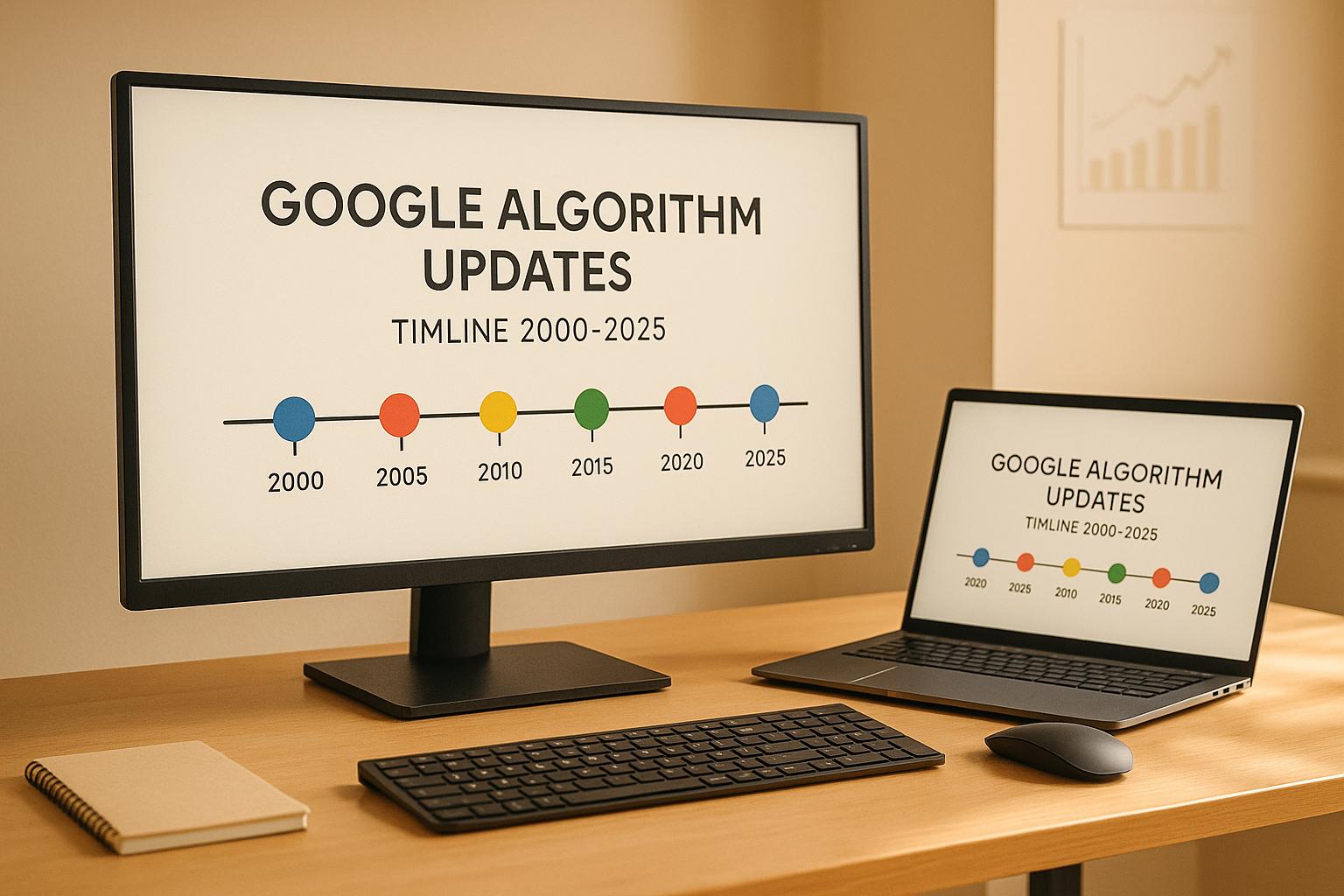Google’s search algorithm has evolved dramatically since 2000, with thousands of updates shaping how websites rank. On average, Google makes 9 changes daily, totaling over 3,200 updates annually. These updates aim to improve search quality, penalize manipulative tactics, and prioritize user-friendly, high-quality content. Key milestones include:
- 2000s: Focused on eliminating keyword stuffing and poor content.
- 2010–2012: Prioritized content quality and penalized spammy backlinks.
- 2013–2017: Shifted to understanding user intent and mobile optimization.
- 2018–2021: Emphasized expertise, authoritativeness, and trustworthiness (E-A-T).
- 2022–2025: Integrated AI to improve search results and reduce low-quality content.
These updates demand consistent monitoring and adjustments in SEO strategies. The focus has shifted from gaming the system to delivering content that genuinely meets user needs. Staying informed about changes and maintaining high-quality, mobile-friendly, and trustworthy content is essential to thrive in search rankings.
A Brief History of Official Google Updates
Google Algorithm Updates by Time Period
Over the past 25 years, Google’s search algorithm has undergone a remarkable transformation. Each phase introduced changes that reshaped search quality and user experience, presenting new challenges and opportunities for SEO professionals. Here’s a breakdown of how these updates shifted SEO strategies over time.
Early 2000s: Tackling Manipulative Tactics
In the early 2000s, Google began cracking down on manipulative SEO practices. The Florida update in 2003 was a game-changer, targeting keyword stuffing and low-quality content. This sent a clear message: gaming the system wouldn’t guarantee high rankings anymore.
Websites had to pivot from keyword manipulation to creating content that genuinely served users. This shift laid the groundwork for Google’s long-term focus on quality, setting a baseline for the changes that followed.
2010–2012: Prioritizing Content Quality
The launch of the Panda update in 2011 and the Penguin update in 2012 marked a turning point. Panda focused on eliminating thin, duplicate, or poor-quality content, while Penguin went after manipulative link-building schemes and over-optimization.
These updates forced websites to abandon quick-fix tactics like article spinning and spammy backlinks. Instead, SEO strategies had to prioritize sustainable, high-quality content. This era firmly established content quality as a core ranking factor and paved the way for Google’s deeper focus on user intent.
2013–2017: Understanding Intent and Mobile Optimization
With the Hummingbird update in 2013, Google shifted its attention from simple keyword matching to understanding user intent. Then came Mobilegeddon in 2015, emphasizing the importance of mobile-friendly websites, and RankBrain, also in 2015, which introduced machine learning to better interpret ambiguous queries.
This period marked a shift from a keyword-centered approach to a user-focused one. Understanding why users searched for something – and ensuring content was accessible on mobile devices – became critical. These innovations laid the foundation for even stricter quality standards in the years ahead.
2018–2021: E-A-T Standards and Core Updates
In 2018, the Medic update highlighted the importance of Expertise, Authoritativeness, and Trustworthiness (E-A-T). This was especially crucial for "Your Money or Your Life" (YMYL) topics, such as health and finance, where credibility could directly impact users’ well-being.
Google’s BERT update in 2019 further advanced its ability to understand context and nuance in search queries. During this time, broad core updates became more frequent, reinforcing the need for consistently high-quality, user-first content. The emphasis on E-A-T forced content creators to demonstrate their knowledge and reliability, setting the stage for even more sophisticated quality assessments.
2022–2025: AI-Powered Search and Refinements
In recent years, Google’s updates have accelerated, with AI playing a central role. In 2022 alone, Google made 4,725 changes to search – an average of 13 updates per day. Recent updates have targeted spammy, AI-generated content designed to manipulate rankings. For example, the March 2024 Core Update aimed to reduce unhelpful content in search results by 40%.
AI now drives much of Google’s search result generation, focusing on delivering relevant, user-centered content. As John Mueller, Google Search Advocate, explained:
"to continue our work to improve the quality of our search results by showing more content that people find genuinely useful and less content that feels like it was made just to perform well on Search".
Key Outcomes by Time Period
| Time Period | Key Goals | Outcomes |
|---|---|---|
| Early 2000s | Penalizing keyword stuffing and poor content | Improved search relevance |
| 2010–2012 | Emphasizing content quality and reducing spam | Higher-quality content ranking, less spam |
| 2013–2017 | Understanding search intent and mobile optimization | Better user intent matching, mobile-friendly results |
| 2018–2021 | Strengthening E-A-T standards and core updates | Increased focus on expertise and trustworthiness |
| 2022–2025 | Fighting spam and integrating AI | Enhanced search quality, AI-driven experiences |
From battling keyword stuffing to leveraging AI for nuanced search results, Google’s evolution represents a monumental shift in how search engines operate. Each phase built on the last, addressing new challenges and refining the search experience in an ever-changing digital world.
How Major Algorithm Updates Changed SEO
Over the years, Google’s algorithm updates have reshaped the way SEO professionals approach their craft. These updates have pushed the industry to abandon outdated methods and adopt strategies that align with Google’s evolving standards, fundamentally altering the SEO landscape.
Changes in Ranking Factors
Google’s ranking factors have become more sophisticated, demanding higher standards for content and website practices.
- Content quality became a priority with the 2011 Panda update, which targeted thin, duplicate, and low-value content. This made tactics like keyword stuffing and spinning articles obsolete.
- The Penguin update in 2012 shifted focus from the quantity of backlinks to their quality. Links are now judged on their relevance and authority, steering SEO efforts away from link farms to building meaningful, high-quality backlinks.
- With BERT’s introduction in 2019, the emphasis moved toward understanding natural language and user intent. This update encouraged the use of conversational language and long-tail keywords to better meet user needs.
- Core Web Vitals, introduced more recently, incorporated metrics like page loading speed, interactivity, and visual stability into ranking factors. These changes tied technical performance directly to user experience.
- The rise of E-A-T (Expertise, Authoritativeness, Trustworthiness) further underscored the importance of credibility, particularly for sensitive topics like health, finance, and law. Google now evaluates the qualifications of content creators and the reliability of websites, especially for "Your Money or Your Life" content.
These updates reflect a clear shift toward prioritizing user-focused, high-quality content and technical excellence.
Effects Across the Industry
The impact of these algorithm updates has been felt across the SEO industry, forcing businesses and content creators to adapt.
For example, Google’s March 2024 Core Update reduced the presence of low-quality content in search results by 45%. This demonstrated the growing ability of algorithms to identify and demote unhelpful content.
Mobile-first indexing changed the game by prioritizing mobile versions of websites for ranking. Businesses had to rethink their web strategies, ensuring mobile optimization became a primary focus rather than an afterthought.
Some companies made significant adjustments in response to updates. After the Panda update, EzineArticles.com raised its content standards and removed large volumes of poor-quality submissions. Similarly, WPMU DEV conducted a large-scale cleanup of low-quality backlinks, reaching out to webmasters to remove harmful links and focusing on building organic, high-quality ones.
User interaction metrics, such as click-through rates, bounce rates, and dwell time, now influence rankings as well. This shift has made engaging, in-depth content a necessity. The average first-page result now contains about 1,400 words, designed to thoroughly address user queries.
Side-by-Side Update Comparison
The table below outlines some of the most influential updates, their goals, and their impact on the industry:
| Update | Primary Goal | Key Ranking Factors Affected | Industry Impact |
|---|---|---|---|
| Panda (2011) | Eliminate low-quality content | Content quality, duplicate content, thin pages | Pushed for original, valuable content |
| Penguin (2012) | Combat link spam | Link quality, anchor text diversity, natural link profiles | Reduced reliance on link farms and paid links |
| Hummingbird (2013) | Understand search intent | Semantic search, conversational queries, context | Shifted focus to user intent over keywords |
| Mobilegeddon (2015) | Improve mobile experience | Mobile-friendliness, responsive design | Accelerated mobile-first design adoption |
| RankBrain (2015) | Process ambiguous queries | Machine learning, query interpretation | Encouraged addressing varied search intents |
| BERT (2019) | Understand natural language | Context, conversational content | Prioritized natural writing over keyword targeting |
| Core Web Vitals (2021) | Enhance user experience | Page speed, interactivity, visual stability | Made technical performance a ranking factor |
This progression highlights how Google’s updates have moved away from easily manipulated signals, like keyword density, toward genuine quality indicators. As Joe Friedlein of Browser Media observed:
"If you are consistently trying to improve your website for your users rather than attempting to outwit search engines, I still maintain that you really do not need to worry about algorithm updates".
Google’s commitment to delivering better search experiences is evident in its rigorous testing process. In 2022 alone, the company conducted 13,280 live traffic experiments and 894,660 search quality tests.
The focus on brand signals – such as mentions and branded searches – further rewards businesses that establish genuine authority and recognition. This evolution continues to encourage strategies that prioritize users over technical shortcuts.
sbb-itb-880d5b6
How to Handle Google Algorithm Changes
Google’s algorithm is constantly evolving, with a staggering 4,725 changes made in 2022 alone – an average of 13 updates per day. Keeping up with these shifts is essential for maintaining and improving your search visibility. Here’s how you can stay ahead.
SEO Best Practices to Follow
Google’s updates often shift the playing field, making it crucial to adjust your strategy. These steps can help you tackle the challenges posed by changing ranking factors:
- Prioritize E-E-A-T (Experience, Expertise, Authoritativeness, Trustworthiness): Clearly display author credentials and reference reliable sources. This is especially critical for sensitive topics like health, finance, and legal advice. These factors help build trust with both users and search engines.
- Build a strong brand: A recognizable and trusted brand is more likely to weather algorithm updates. Focus on creating content that people naturally want to share, mention, and link to.
- Enhance user experience: Use tools like Google PageSpeed Insights to improve Core Web Vitals, including page speed, interactivity, and visual stability. Since Google uses mobile-first indexing, ensure your site is fully optimized for mobile devices.
- Audit your content regularly: Remove thin, outdated, or duplicate content that could harm your site’s authority. Refresh older content with updated data, examples, or case studies to keep it relevant.
- Improve internal linking: A logical linking structure helps search engines understand your content’s relationships. Use descriptive anchor text and organize your site into topic clusters to demonstrate expertise in specific areas.
Tracking and Responding to Updates
Staying informed and prepared is just as important as implementing best practices. Here’s how to stay on top of algorithm changes:
- Monitor official Google channels: Follow announcements on platforms like Google’s Search Central Blog. Set up Google Alerts for terms like "Google Core Update" to receive timely updates.
- Use Google Search Console: This tool is essential for tracking changes in impressions, clicks, and average position. It also helps you identify manual actions or security issues that may arise.
- Leverage advanced tracking tools: Tools that monitor ranking fluctuations, identify affected pages, and provide historical data can give you deeper insights into how updates impact your site.
- Develop a strategic response plan: Avoid making hasty changes. Instead, analyze which pages are affected and look for common issues like content quality, technical SEO problems, or link-related concerns. A sitewide review of content, traffic, technical SEO, and backlinks often reveals the root causes of ranking drops.
For example, the March 2024 Core Update underscored the importance of quality content and user experience. Sites with thin or manipulative content saw significant drops, while those focused on delivering value to users often experienced gains.
Using SEO Resources and Expert Help
Sometimes, navigating algorithm updates requires outside expertise. Here’s how external resources can help:
- Seek professional assistance: If updates impact your visibility, agencies like SearchX can provide advanced audits and strategic planning. Their technical SEO services help identify vulnerabilities and prepare your site for future updates.
- Engage with the SEO community: Stay informed through trusted sources like Search Engine Journal, Moz, and industry experts on social media. These channels often provide timely insights and interpretations of updates.
- Invest in comprehensive SEO audits: Persistent ranking issues may require a professional audit to uncover technical problems, content gaps, or misaligned strategies. Services like SearchX’s SEO solutions offer in-depth analysis and actionable recommendations.
- Educate your team: Building a strong foundation in SEO fundamentals enables your team to make informed decisions. Resources like DIY local SEO can empower smaller businesses to handle routine optimizations while knowing when to call in experts.
As Irina Maltseva, Founder at ONSAAS, puts it:
"Google’s algorithm updates are the driving force behind SEO. With each new update’s introduction, the ranking rules in search engine results change. There is no one-size-fits-all approach to SEO anymore".
Rather than seeing algorithm updates as barriers, view them as opportunities to improve your site’s value for users. Businesses that focus on meeting user needs, instead of trying to outsmart the system, are better equipped to thrive when updates roll out.
Conclusion: Google’s Algorithm Keeps Changing
Recent data highlights how quickly Google’s algorithm evolves, and there’s no indication it’s slowing down. This constant change means that what works today might not work tomorrow, making it crucial to stay alert and adjust strategies regularly.
As Plego points out:
"If you fail to track changes and any updates to Google’s algorithm, your search rankings and organic traffic will decline. This means that your return on investment will decrease because people aren’t being directed to your website. If they’re not directed to your website, your conversions will drop and you’ll see a major drop in overall revenue."
- Plego
The impact of recent core updates has made this clear. Companies that neglected content quality saw their traffic plummet, while those focused on delivering real value to users often came out ahead.
Viewing updates as opportunities rather than obstacles is key. Businesses that focus on improving user experience and content quality are better equipped to handle algorithm changes. EmilyWest from Seer Interactive explains:
"Staying ahead of Google’s updates demands a proactive, data-driven approach. By focusing on creating user-centric content, optimizing for technical performance, and continuously monitoring your SEO efforts, you can build a resilient strategy that adapts to changes rather than reacting to them."
- EmilyWest
For many businesses, professional SEO support can make all the difference. In-house teams often lack the time or expertise to keep up with Google’s rapid changes. Resources like SearchX provide specialized tools and continuous monitoring to help businesses stay visible. Their technical SEO services and SEO solutions are designed to handle these challenges, allowing companies to focus on their core goals.
As Google sharpens its focus on user intent and content quality, the SEO world will keep shifting. Success lies in embracing these changes, adopting sustainable practices, and seeking expert guidance when needed. Each update is a chance to refine your approach and prove the value of your content. Instead of dreading what’s next, see it as an opportunity to improve and thrive.
FAQs
How do Google algorithm updates influence SEO strategies for businesses looking to boost their search rankings?
Google’s algorithm updates significantly influence SEO strategies by emphasizing high-quality, relevant content while discouraging outdated or manipulative tactics. These changes often impact search rankings, making it crucial for businesses to stay updated and adjust their approaches promptly.
To stay competitive, concentrate on producing content that prioritizes user needs, fine-tune technical SEO elements, and follow Google’s guidelines closely. Staying ahead of these updates helps ensure your strategies meet current search engine standards, paving the way for consistent growth in search visibility.
What factors does Google prioritize in its algorithm to rank high-quality content?
Google’s algorithm takes several factors into account when determining how to rank content. Key elements include the relevance of the content to the user’s search query, its originality, and how helpful it is for the intended audience. Content that matches user intent, backed by authoritative backlinks, strong website credibility, and positive user engagement metrics (like the time visitors spend on a page), tends to perform better.
On the technical side, Google places a high value on mobile-friendly design, fast page load times, and secure connections (using HTTPS). Focusing on these technical and content-related factors not only boosts your site’s visibility but also enhances the overall experience for your visitors.
How can businesses stay ahead of Google algorithm updates to maintain strong search rankings?
To keep up with Google’s algorithm updates, businesses should focus on producing content that genuinely serves their audience. Content that informs, entertains, or solves problems is much more likely to resonate with users and perform well in search rankings. Conducting regular SEO audits is also crucial. These audits can pinpoint weak spots, like low-quality content or technical glitches, that might be dragging your site down.
It’s also important to stay in the loop. Follow reputable SEO blogs, attend industry events, and keep tabs on Google’s announcements. On top of that, regularly review your website’s traffic and performance metrics. This helps you quickly identify dips in visibility and make adjustments as needed. By staying vigilant and sticking to proven SEO practices, businesses can navigate algorithm changes and protect their rankings.




